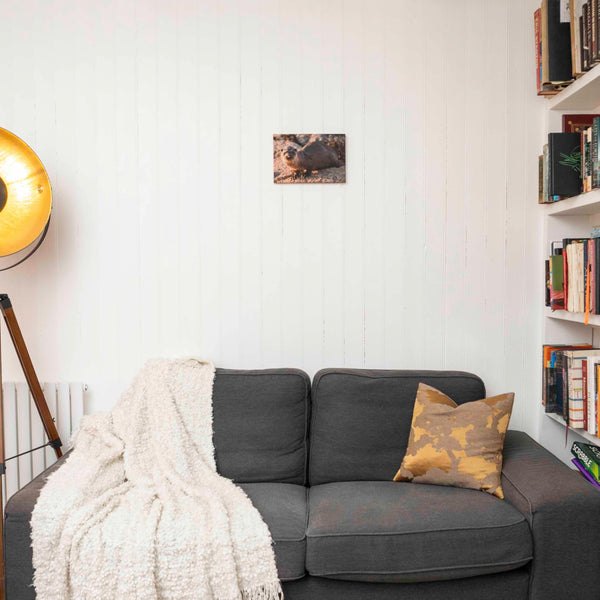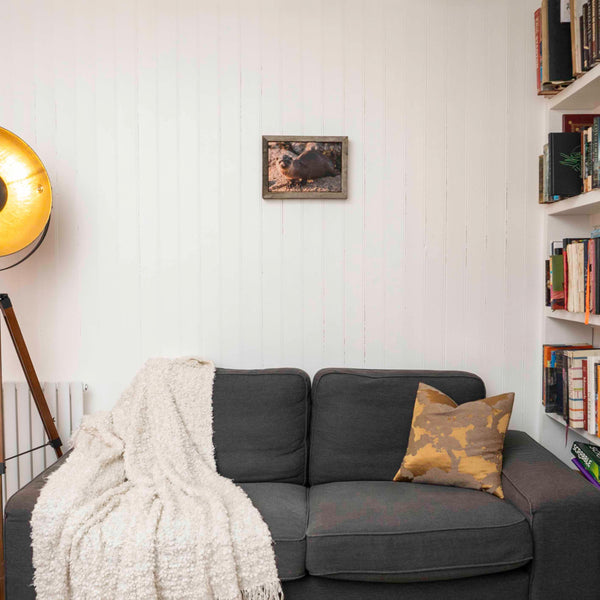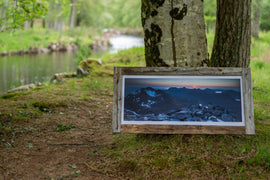Otter, Applecross Wildlife, Photographed By Jack Marris
Ideal for nature lovers, this curious sea otter was captured down near Coral Beach near Culduie, after lots of work tracking their movements.
This canvas print brings a touch of Scotland's wild to any wall space.
Story From Behind The Lens
Print Guide
Hand-Stretched Canvas
At The Applecross Photographic Gallery, we use high-grade, UV resistant canvas, and a professional-grade 12-ink printer. This advanced technology captures the full tonal range and precise colour of Jack Marris' Highland photography, ensuring each piece has remarkable clarity and longevity.
Every canvas is hand-stretched in-house over durable pinewood frames crafted by local artisans, creating a unique, authentic addition to your decor. Your order arrives ready to hang, bringing the beauty of the Highlands straight to your space.
Floating Post Frames (Small Framed Canvases)
Floating post frames provide a contemporary way to display your favourite Scottish prints. The prints appear to "float" within the frame, giving a clean and modern aesthetic that enhances the artwork. These frames are a great option for those looking for a sleek, minimalist presentation.
Larch Post Frames (Medium Framed Canvases)
Larch post frames offer a rustic and unique way to display your favourite Scottish prints. Crafted from reclaimed larch fence posts, each frame carries its own natural character and history, adding warmth and texture to the artwork. These frames are perfect for those who appreciate a more organic, earthy aesthetic while supporting sustainable practices.
Fine Art Prints
Our fine art prints are crafted on premium paper for lasting quality and vibrant detail. Available in two sizes and signed by Jack, these prints bring the Highlands to life. Check our sizing guide for easy conversion from inches to centimetres. Each print is shipped in a protective tube, ready for you to frame or present as you wish.
Mounted Prints
For a compact display, choose our small mounted print, professionally mounted in-house with care. These prints capture the beauty of Applecross and the Scottish Highlands in a format that’s perfect for any space.
Size Guide
Standard 3:2 Aspect Ratio
These sizes offer a classic 3:2 ratio that balances well in a variety of spaces, ideal for showcasing Highland landscapes with depth & proportion.
-
Small (12x8 inches / 30x20 cm)
- Dimensions: 12 x 8 inches (30 x 20 cm)
- Best suited for: Desks, shelves, smaller spaces, or as part of a gallery wall arrangement.
-
Medium (24x16 inches / 60x40 cm)
- Dimensions: 24 x 16 inches (60 x 40 cm)
- Best suited for: Focal points on mid-sized walls in living rooms, offices, or hallways.
-
Large (36x24 inches / 90x60 cm)
- Dimensions: 36 x 24 inches (90 x 60 cm)
- Best suited for: Bold displays in living rooms, above sofas, beds, or in gallery spaces.
Panoramic Aspect Ratio
Designed for wide, sweeping vistas, our panoramic canvases bring an expansive feel to any room, emphasizing the grandeur of Highland landscapes.
-
Small Panoramic (22x8 inches / 55x20 cm)
- Dimensions: 22 x 8 inches (55 x 20 cm)
- Best suited for: Compact spaces, adding a horizontal element to shelves, hallways, or smaller rooms.
-
Medium Panoramic (40x16 inches / 100x40 cm)
- Dimensions: 40 x 16 inches (100 x 40 cm)
- Best suited for: Mid-sized walls, ideal above desks or in entryways.
-
Large Panoramic (60x22 inches / 150x55 cm)
- Dimensions: 60 x 22 inches (150 x 55 cm)
- Best suited for: Making an impression on wider walls in living rooms or dining areas.
-
Extra Large Panoramic (80x30 inches / 200x75 cm)
- Dimensions: 80 x 30 inches (200 x 75 cm)
- Best suited for: A powerful, immersive experience on expansive walls, perfect for large spaces or gallery installations.
Quality Assurance
Each canvas is hand-stretched in-house for durability and vibrant detail, with frames crafted locally, ensuring a unique and authentic addition to your décor.
Please contact us if you have any questions, we are happy to help.





























